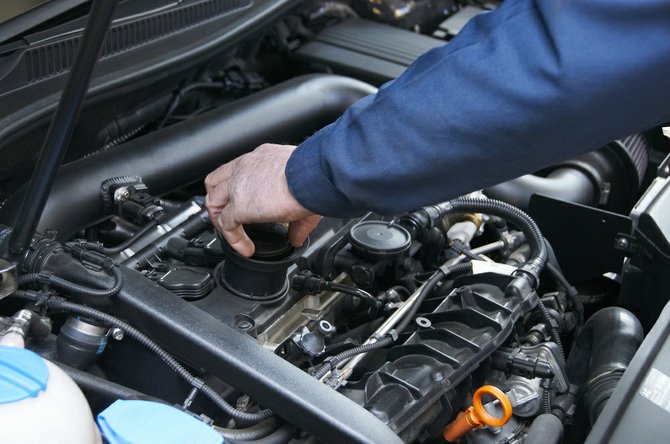A.J. McKay's Auto Repair will make sure you're prepared for the Summer heat. We provide full service and repair for most auto and RV air conditioners.

Summer is quickly approaching, which means your vehicle's air conditioning system will be put to the test. If your system hasn't been serviced in a while, now is the time.
While most newer vehicles can get away with simply having their A/C recharged, older cars and trucks may require a little more attention. Don't worry if the laundry list of parts your mechanic says you need confuses you; here are the specifics.
If you believe your air conditioner isn't as frosty as it once was, but it's still blowing cold, the system may need to be recharged. While manufacturers used to use R-12, or Freon, as a refrigerant, researchers have discovered that it is a major cause of ozone depletion. As a result, using Freon in your car is now illegal. Manufacturers have used R-134a to keep things cold in the cabin since 1994.
While you can technically recharge your vehicle's refrigerant yourself, it's best to leave it to a qualified professional if you're not confident in vehicle maintenance. Because all refrigerants have a tendency to displace oxygen, if you accidentally evacuate the system, the stuff could literally push the air out of your lungs. It's not fun.
First Steps
Once you take your car in, technicians will measure the amount of pressure in your system, and if it's low, they'll add enough to get the reading within your manufacturer's specifications. They will then run your car for a few minutes with the A/C on high and use a special thermometer to measure the system's output. If it's not within the necessary parameters, you may have a leak somewhere in your system.
If you do have a leak, your technician will hook your vehicle up to a special refrigerant recovery system and drain any of the harmful gas from your car. At this point, the technician will inspect all of your air conditioning hard lines to make sure there are no obvious cracks. They may add a tracer dye to the system to help out. The good news is, your expensive hard lines are usually made of aluminum and rarely fail. Instead, it's likely one of your system's components is the culprit. First up is your compressor.
The Components
An air conditioning compressor is usually driven by your vehicle's serpentine belt, and as it spins, it pressurizes the system's refrigerant. Simply put, it's this change in pressure that cools the air coming into your cabin. An A/C compressor spins at a dizzying rate, and the more you use the cool side of your thermostat, the more likely it is to eventually fail or leak. One of the main differences between R-12 and R-134a is that the new refrigerant requires supplementary oil to be added to the system to make everything function. R-12 did not. If your compressor has run low on oil, it's possible the interior seals have failed and you'll need a new unit. Unfortunately, compressors aren't cheap.
The best way to keep your compressor from failing is to have your A/C system serviced once a year, including the addition of the right kind of lubrication for your unit. If it does come down to replacing your compressor, most responsible shops will recommend going ahead and swapping out a number of periphery components at the same time. Why? The easy answer is working on an air conditioning system is about as much fun as sticking your hand in a blender. Twice. So to avoid draining your refrigerant, removing your compressor, installing a new unit and refilling the system with new cool stuff, only to have you come back in a week and say it's still not cold enough, it makes sense to replace everything you can. It keeps you from having to waste time and money, and it makes sure they get the problem solved the first time.
But before we get to all of the tiny bits and pieces that get swapped out during a normal compressor replacement, there is another possible culprit for a leaking system is your condenser. A condenser is basically a large heat exchanger, usually located in the front of your vehicle's engine bay. It looks a little like a small radiator, and since it is exposed to oncoming air, it may get hit by debris as well. If your condenser has been struck by a rock or some other flying material, it may be your culprit.
If your condenser turns out to be ok, your technician may recommend swapping out a number of tidbits, including your receiver dryer, evaporator and expansion valve. If your head's spinning, don't worry. All of the pieces are essential to how chilly things get inside of your car. The receiver dryer, for instance, pulls condensation out of your refrigerant. This is important because when water mixes with R-134a, it creates a corrosive acid that will degrade your A/C system rapidly.
Your evaporator, on the other hand, is essential to the refrigerant's change from a gas to a liquid. That change is essential to how well your system cools. If your evaporator isn't functioning at max capacity, your A/C won't either.
Similarly, the expansion valve acts as a gatekeeper, deciding how much refrigerant makes it into the evaporator. The more R-134a the system needs, the more the expansion valve opens. Obviously, if your expansion valve isnít working properly, your air conditioning system isn't going to be at its best.
Though a technician could theoretically remove and test each and every individual piece of your system, most of these parts have a similar shelf life. If one has gone bad, itís usually only a matter of time before another fails. Instead of having on-again off-again air conditioning, it's usually best to simply take your mechanic's advice and replace what he or she recommends.



